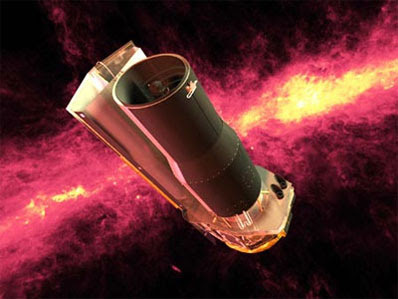Astronomy

- Airborne Telescope
Airborne telescope will unlock secrets of the cosmos A NASA jumbo jet that will help scientists unlock the origins of the universe with infrared observations reached a milestone December 18 when doors covering the plane's telescope were fully opened...
- Graveyards Of Solar Systems Around Dead Suns
Using NASA's Spitzer Space Telescope to study white dwarf stars, astronomers have found the dusty remains of ancient solar systems. White dwarfs are the dense glowing embers of Sunlike stars. While their atmospheres should consist entirely of hydrogen...
- Cool Stars Have Different Mix Of Life-forming Chemicals
Life on Earth is thought to have arisen from a hot soup of chemicals. Does this same soup exist on planets around other stars? A new study from NASA's Spitzer Space Telescope hints that planets around stars cooler than our sun might possess a different...
- Liquid Found In Saturn
The liquid found on Saturn's moon, Titan makes one of the most exciting and challenging discoveries of our century, since besides Earth, this is the second solar body with liquid on the surface in the system. The lake-like formations contain liquid...
- Planets Like Binary Stars, Too
In our solar system, planets, comets, asteroids, and dwarf-planets all orbit around a single star, our Sun. But imagine if we could witness two Suns in our sky. NASA's Spitzer Space Telescope has helped astronomers see that planetary systems are...
Astronomy
Spitzer Space Telescope to embark on new, warmer life

Scientists are bracing for the loss of two key instruments aboard NASA's infrared Spitzer Space Telescope, which will considerably diminish the observatory's ability to image infant stars but unlock more time for more thorough studies of mysterious worlds outside the solar system.
Officials expect Spitzer will drain its supply of liquid helium some time next month, reducing the telescope's sensitivity to infant stars and distant galactic nuclei.
Engineers have calculated the helium will probably run out around May 12.
Spitzer, the last of NASA's Great Observatories designed to revolutionize astronomy, was launched in 2003 with about 95 gallons of frigid liquid helium chilled to about -457 degrees Fahrenheit. That number equates to 1.2 degrees Kelvin, nearly as cold as the point of absolute zero.
The spacecraft was launched at room temperature and the cryogenic helium began cooling the 33.5-inch-diameter telescope before operations began in late 2003.
The spacecraft was launched at room temperature and the cryogenic helium began cooling the 33.5-inch-diameter telescope before operations began in late 2003.
Sensors for the observatory's three science instruments are mounted inside a structure called the cryostat, which is actively cooled by vapors vented from the adjacent liquid helium tank.
The instruments must be maintained at such cold temperatures to see through relatively cool dust clouds and observe star-forming regions hidden from optical telescopes.
When Spitzer empties the liquid helium tank, the spacecraft will automatically detect the slight warming of the cryostat.
The instruments must be maintained at such cold temperatures to see through relatively cool dust clouds and observe star-forming regions hidden from optical telescopes.
When Spitzer empties the liquid helium tank, the spacecraft will automatically detect the slight warming of the cryostat.
The spacecraft will go into a planned anomalous condition, basically a standby mode.
It will take about a day to recover from the fault, and then the Spitzer ground team will begin monitoring the telescope as the cryostat warms to about 30 degrees Kelvin, still a bone-chilling -405 degrees Fahrenheit.
Assuming Spitzer runs out of helium in the middle of May, scientists hope to begin "warm" operations by the end of June.
Scientists will only be able to use part of the capacity of Spitzer's Infrared Array Camera, an instrument with four detector channels ranging from near-infrared to mid-infrared wavelengths.
Warm observations will be limited to two wavelengths in the near-infrared spectrum.
Scientists will only be able to use part of the capacity of Spitzer's Infrared Array Camera, an instrument with four detector channels ranging from near-infrared to mid-infrared wavelengths.
Warm observations will be limited to two wavelengths in the near-infrared spectrum.
- Airborne Telescope
Airborne telescope will unlock secrets of the cosmos A NASA jumbo jet that will help scientists unlock the origins of the universe with infrared observations reached a milestone December 18 when doors covering the plane's telescope were fully opened...
- Graveyards Of Solar Systems Around Dead Suns
Using NASA's Spitzer Space Telescope to study white dwarf stars, astronomers have found the dusty remains of ancient solar systems. White dwarfs are the dense glowing embers of Sunlike stars. While their atmospheres should consist entirely of hydrogen...
- Cool Stars Have Different Mix Of Life-forming Chemicals
Life on Earth is thought to have arisen from a hot soup of chemicals. Does this same soup exist on planets around other stars? A new study from NASA's Spitzer Space Telescope hints that planets around stars cooler than our sun might possess a different...
- Liquid Found In Saturn
The liquid found on Saturn's moon, Titan makes one of the most exciting and challenging discoveries of our century, since besides Earth, this is the second solar body with liquid on the surface in the system. The lake-like formations contain liquid...
- Planets Like Binary Stars, Too
In our solar system, planets, comets, asteroids, and dwarf-planets all orbit around a single star, our Sun. But imagine if we could witness two Suns in our sky. NASA's Spitzer Space Telescope has helped astronomers see that planetary systems are...
